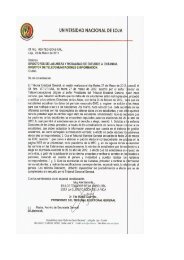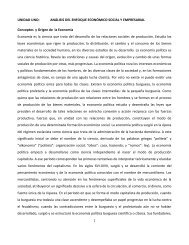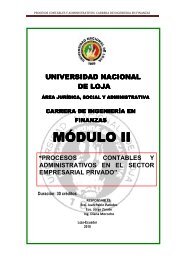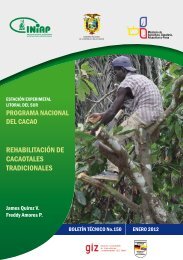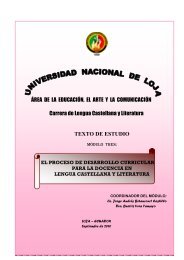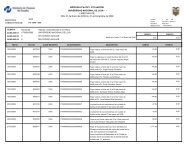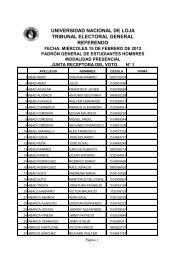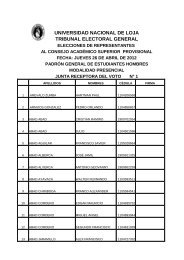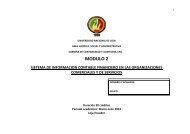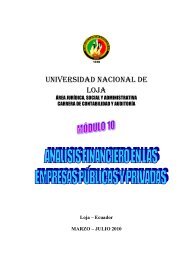module 5 planning of the english language teaching-learning process
module 5 planning of the english language teaching-learning process
module 5 planning of the english language teaching-learning process
Create successful ePaper yourself
Turn your PDF publications into a flip-book with our unique Google optimized e-Paper software.
UNIVERSIDAD NACIONAL DE LOJA<br />
Área de la Educación el Arte y la Comunicación<br />
English Language Career<br />
4. Phonemic symbols. Pointing to phonemic symbols is helpful when<br />
learners make pronunciation mistakes, for example using a long vowel<br />
/u:/when <strong>the</strong>y should have used a short one /u/, or when <strong>the</strong>y<br />
mispronounce a consonant. You can only use this technique with<br />
learners who are familiar with <strong>the</strong> relevant phonemic symbols.<br />
5. Echo correcting means repeating. Repeating what a learner says with<br />
rising intonation will show <strong>the</strong> learner that <strong>the</strong>re is a mistake somewhere.<br />
You will find this technique works well when learners have made small<br />
slips which you feel confident <strong>the</strong>y can correct <strong>the</strong>mselves.<br />
6. Identifying <strong>the</strong> mistake. Sometimes we need to identify <strong>the</strong> mistake by<br />
focusing learners' attention on it and telling <strong>the</strong>m that <strong>the</strong>re is a problem.<br />
This is a useful technique for correcting errors. We might say things like<br />
'You can't say it like that' or 'Are you sure?' to indicate that <strong>the</strong>y have<br />
made a mistake.<br />
7. Not correcting at <strong>the</strong> time when <strong>the</strong> mistake is made. We can use this<br />
technique to give feedback after a fluency activity, for example. It is<br />
better not to correct learners when <strong>the</strong>y are doing fluency activities, but<br />
we can make notes <strong>of</strong> serious mistakes <strong>the</strong>y make. At <strong>the</strong> end <strong>of</strong> <strong>the</strong><br />
activity, we can say <strong>the</strong> mistakes or write <strong>the</strong>m on <strong>the</strong> board and ask<br />
learners what <strong>the</strong> problems are.<br />
8. Peer and self-correction. Peer correction is when learners correct each<br />
o<strong>the</strong>r's mistakes. Self-correction is when learners correct <strong>the</strong>ir own<br />
mistakes. Sometimes we need to indicate that <strong>the</strong>re is a mistake for <strong>the</strong><br />
learners to correct it. Sometimes <strong>the</strong>y notice <strong>the</strong> mistake <strong>the</strong>mselves and<br />
quickly correct it. Peer and self-correction help learners to become<br />
independent <strong>of</strong> <strong>the</strong> teacher and more aware <strong>of</strong> <strong>the</strong>ir own <strong>learning</strong> needs.<br />
9. Ignoring mistakes. In fluency activities we <strong>of</strong>ten ignore all <strong>the</strong> mistakes<br />
while <strong>the</strong> activity is in progress, as <strong>the</strong> important thing is for us to be able<br />
to understand <strong>the</strong> learners' ideas and for <strong>the</strong> learners to get fluency<br />
practice. We can make a note <strong>of</strong> frequent mistakes and correct <strong>the</strong>m with<br />
<strong>the</strong> whole class after <strong>the</strong> activity. We <strong>of</strong>ten also ignore mistakes which<br />
are above <strong>the</strong> learners' current level. For example, an elementary learner<br />
telling us about what he did at <strong>the</strong> weekend might make a guess at how<br />
to talk about past time in English. We would not correct his mistakes<br />
because <strong>the</strong> past simple is a structure we have not yet taught him. We<br />
may also ignore mistakes made by a particular learner because we think<br />
this is best for that learner, e.g. a weak or shy learner. Finally, we <strong>of</strong>ten<br />
also ignore slips as learners can usually correct <strong>the</strong>se <strong>the</strong>mselves.<br />
Written correction<br />
In next unit we will see how we can use a correction code to show learners<br />
where some <strong>of</strong> <strong>the</strong>ir mistakes are and what kind <strong>the</strong>y are. O<strong>the</strong>r techniques for<br />
making written corrections are:<br />
[Escribir texto] Página 108



